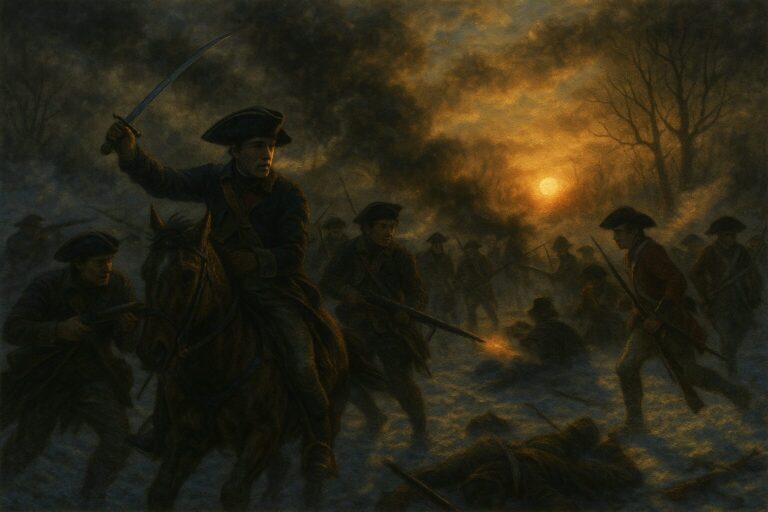Intro
1776: New Jersey
The First Battle of Springfield on December 17, 1776, though overshadowed by the later and larger battle in 1780, was a significant and often forgotten engagement in the darkest days of the American Revolution. It occurred during Washington’s retreat across New Jersey, following the fall of Fort Lee, as British and Hessian forces pushed aggressively westward to crush the rebellion before the year ended.
By mid-December 1776, General George Washington’s army was in dire straits. Morale was low, enlistments were expiring, and the British had captured New York and pursued the rebels across New Jersey. Washington’s forces were retreating toward the Delaware River. Loyalist sentiment in New Jersey was growing, and American hopes were dim.
Springfield, NJ, became a critical choke point during this retreat. It lay along the Rahway River crossings and key roads leading to Morristown, where Washington hoped to regroup. Controlling Springfield meant slowing the British advance.
A cold hush lay over the Rahway River valley as dawn bled into December 17, 1776. Frost rimed the timber rails of Springfield’s bridge, and thin‐skinned ice crackled beneath the hooves of picketed horses. In the half-light, a ragged knot of New Jersey militiamen—farmers and tradesmen from Union, Essex, Morris, Somerset and Hunterdon Counties—waited in uneasy silence. Among them stood Captain Samuel Ford of Morristown, the wool collar of his hunting shirt stiff with frozen breath, flintlock cradled close to keep the powder dry.
Across the meadows the deep, measured drums of General Charles Cornwallis’s column rolled closer. Red coats and blue-green Hessian facings flickered through the mist like sparks in ashes. Only this little bridge over the Rahway barred their road to Morristown, where Washington was gathering what remained of the Continental Army. If the enemy crossed here unopposed, the heart of the rebellion might be cut out before Christmas.
The defense had fallen to Colonel Elias Dayton’s 3rd New Jersey Regiment—veteran Continentals who had been fighting rearguard actions since the fall of Fort Lee—and to every militiaman he could sweep into the line. Dayton moved among the pickets with quiet urgency, placing men behind stone walls and split-rail fences, sighting the field pieces, and giving the last grim orders: “Hold them long enough to break the bridge timbers and you buy the army another day.”
Somewhere to the east, rumor whispered, Reverend James Caldwell was exhorting fresh militia at Connecticut Farms, Bible in hand, flintlock at his side—the Fighting Parson raising spirits even if his own pulpit lay miles away. No muster roll proves he reached Springfield in time, yet every man on the line felt his voice in their bones: “Defy tyranny—whatever the cost.”
As the first sunlight struck the musket barrels, British skirmishers surged forward. The Jersey men answered with a rattling volley from behind the fence rails, then fell back yard by yard, firing, loading, and cursing the numbness in their fingers. Captain Ford fought near the bridgehead, directing a squad that pried loose planks and heaved them into the icy current. A Hessian ball tore through his shoulder; he staggered but would not leave the fight until the last spar collapsed into the water.
Smoke drifted low along the river, yellow in the winter sun. At last Dayton’s whistle sounded the retreat. The militia melted westward toward the Short Hills, leaving the bridge a tangled ruin of timbers and ice. Cornwallis’s vanguard reached the shattered span too late to pursue. Evening fell on a British army stalled in Springfield while Washington’s ragged column slipped toward the Delaware.
Captain Samuel Ford lingered nine days with fever and infection before dying December 26, 1776—the very night Washington struck Trenton and breathed new life into the Revolution. Dayton’s men would fight again and, in 1780, stand at Springfield a second time. Reverend Caldwell’s church would burn, yet his sermons would blaze brighter. And the memory of that first, desperate stand on the Rahway—when ordinary Jersey rebels bought precious hours with blood and frozen breath—became an ember carried forward, lighting the path to liberty.

